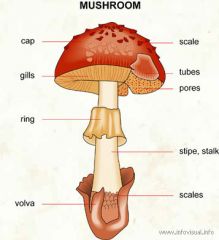![]()
![]()
![]()
Use LEFT and RIGHT arrow keys to navigate between flashcards;
Use UP and DOWN arrow keys to flip the card;
H to show hint;
A reads text to speech;
27 Cards in this Set
- Front
- Back
|
Where are fungus found
|
Everywhere, food, basement walls, people's feet
|
|
|
Unicellular fungus used to make bread, beer, and wine
|
Yeast
|
|
|
Threadlike filaments
|
hyphae
|
|
|
Mycelium
|
A network of hyphae
|
|
|
Cell walls of fungus are composed of
|
chitin
|
|
|
Without fungus there would be large anounts of _______
|
dead organisms and waste
|
|
|
Saprophytes are also known as
|
decomposers
|
|
|
Parasitic fungi produce specialized hyphae called
|
haustoria
|
|
|
Since fungi can not produce their own food they are called
|
heterotrophs
|
|
|
To digest food fungi produce ___________________
|
extracellular digestive fluids
|
|
|
How are the 2 types of spores formed
|
Mitosis and meiosis
|
|
|
A form of asexual reproduction is
|
budding
|
|
|
Can fungus have mutualistic relationships? T or F
|
True
|
|
|
Yeast reproduce by ______
|
Budding
|
|
|
The largest phylum of fungi is
|
Ascomycota
|
|
|
Extracellular digested food is ___________ by fungi
|
absorbed
|
|
|
Reproduction is used to classifiy fungi. T or F
|
True
|
|
|
What is a lichen?
|
Fungus and algae in a symbiotic relationship
|
|
|
Zygospores
|
can withstand harsh conditions
|
|
|
Fungus breakdown organic substances into _________
|
raw materials
|
|
|
Spore containing structure
|
sporangium
|
|
|
Hyphae that grow horizontally along the surface of bread
|
Stolons
|
|
|
Rhiziods
|
Penetrate food
|
|
|
Examples of Deuteromycotes
|
Blue Cheese, used to make soy sauce
|
|

Know the cap, gills, stalk
|
make sure you can identify them
|
|

This is a picture of yeast reproducing. What is this method?
|
Budding
|
|
|
EXTRA CREDIT
EMAIL A PIC OF BIRD NEST FUNGI |
TO amorris@henry.k12.va.us
|

